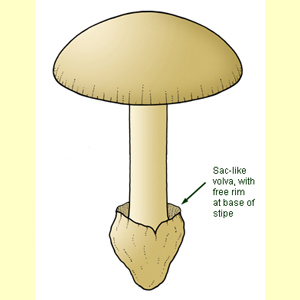
The volva occurs at the base of the stipe, and it is formed from the remnants of a universal veil which may cover the entire fruit-body when young. When the universal veil breaks as the fruit-body expands with maturity, the universal veil can also leave patches of tissue or scales on the pileus surface which are obviously different in texture from the underlying surface. Such patches or scales on the pileus surface can suggest the presence of a volva.
To observe the presence or absence of a volva it is necessary to look carefully at the base of the stipe. Make sure that the stipe base is removed intact from the soil when picking the fruit-body (and the stipe does not break off above the base). A cross section of the stipe base may help in interpreting the structure of the volva.
Choose this state if: there is a distinct saccate (sack-like) volva at the stipe base, or at least the volva forms a narrow free rim of tissue around the base of the stipe. Included under this state is the flaring volva, when the lower part of the volva adheres to the stipe base, and is only free above. A volva that is saccate or with a free rim is often associated with the presence of a large patch of tissue on the pileus. However, in some species all of the universal veil tissue remains at the volva (which is then often very deep) and there are no veil remains on the pileus surface.
